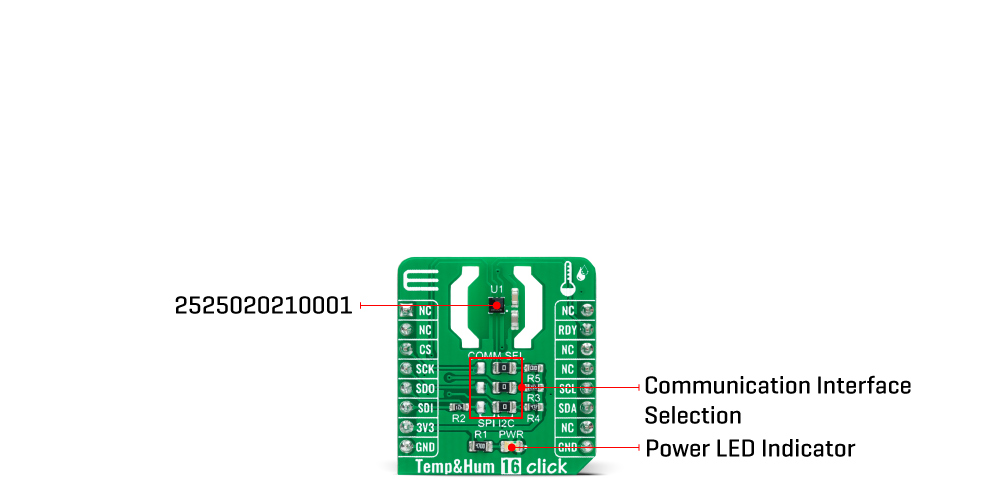






Overview
The Temp&Hum 16 Click Board™ is a compact add-on board that represents temperature and humidity sensing solutions. This board features the WSEN-HIDS (2525020210001), a MEMS-based capacitive humidity sensor with an integrated ASIC and I2C and SPI serial communication from Würth Elektronik. A silicon-based temperature sensor is also integrated within the same package. ASIC contains the multiplier, operational amplifier, analogue-to-digital converter, and other signal conditioning blocks like controller logics and interrupts.
The Temp&Hum 16 Click Board™ converts the analogue signal from humidity and temperature sensing elements into 16-bit digital humidity and temperature values. The WSEN-HIDS is factory calibrated for both humidity and temperature measurements with no further calibration required. This Click Board™ is an ideal solution to be used in various temperature and humidity-related applications.
Downloads
How Does The Temp&Hum 16 Click Board™ Work?
The Temp&Hum 16 Click Board™ as its foundation uses the WSEN-HIDS, a 16-bit digital ultra-low-power and high-performance humidity sensor with digital output interface and embedded temperature sensor for ambient temperature measurement from Würth Elektronik. It measures relative humidity from 0 to 100% RH with an output data rate of up to 12.5Hz. The sensor is fully calibrated with no further calibration required. The initialization of the sensor can be performed by selecting the operation mode (Continuous or One-shot) and output data rate.

After initializing the sensor, it is recommended to check the availability of data samples using an interrupt signal labelled RDY and routed to the INT pin on the mikroBUS™ socket. By default, after powering up, the sensor goes to power-down mode. In power-down mode, all internal blocks are turned off to minimize power consumption. After selecting one of the two operating modes, the sensor is in an active measurement state depending on the output data rate.
The Temp&Hum 16 Click Board™ provides the possibility of using both I2C and SPI interfaces with a maximum frequency of 100kHz in Standard and 400kHz in Fast mode for I2C and 8MHz for 3-wire SPI communication. 3-wire SPI shares a single data line for the data transfer, where the Master and Slave alternate their transmitter and receiver roles synchronously. The communication interface selection can be made by positioning SMD jumpers labelled COMM SEL to an appropriate position. Note that all the jumpers' positions must be on the same side, or else the Click board™ may become unresponsive.
The Temp&Hum 16 Click Board™ can be operated only with a 3.3V logic voltage level. The board must perform appropriate logic voltage level conversion before use with MCUs with different logic levels. However, the Click board™ comes equipped with a library containing functions and an example code that can be used, as a reference, for further development.
SPECIFICATIONS
| Type | Temperature & humidity |
| Applications | The Temp&Hum 16 Click Board™ is an ideal solution to be used in various temperature and humidity-related applications |
| On-board modules | WSEN-HIDS (2525020210001) - MEMS-based capacitive humidity sensor with an integrated ASIC and I2C and SPI serial communication from Würth Elektronik |
| Key Features | Low power consumption, high performance, digital output interface, embedded temperature sensor for ambient temperature measurement, fully calibrated, and more. |
| Interface | I2C,SPI |
| Compatibility | mikroBUS |
| Click board size | S (28.6 x 25.4 mm) |
| Input Voltage | 3.3V |
PINOUT DIAGRAM
This table shows how the pinout of the Temp&Hum 16 Click Board™ corresponds to the pinout on the mikroBUS™ socket (the latter shown in the two middle columns).
| Notes | Pin |  |
Pin | Notes | |||
|---|---|---|---|---|---|---|---|
| NC | 1 | AN | PWM | 16 | NC | ||
| NC | 2 | RST | INT | 15 | RDY | Data-Ready Signal | |
| SPI Chip Select | CS | 3 | CS | RX | 14 | NC | |
| SPI Clock | SCK | 4 | SCK | TX | 13 | NC | |
| SPI Data OUT | SDO | 5 | MISO | SCL | 12 | SCL | I2C Clock |
| SPI Data IN | SDI | 6 | MOSI | SDA | 11 | SDA | I2C Data |
| Power Supply | 3.3V | 7 | 3.3V | 5V | 10 | NC | |
| Ground | GND | 8 | GND | GND | 9 | GND | Ground |
ONBOARD SETTINGS AND INDICATORS
| Label | Name | Default | Description |
|---|---|---|---|
| LD1 | PWR | - | Power LED Indicator |
| JP1-JP3 | COMM SEL | Right | Communication Interface Selection SPI/I2C: Left position SPI, Right position I2C |
TEMP&HUM 16 CLICK ELECTRICAL SPECIFICATIONS
| Description | Min | Typ | Max | Unit |
|---|---|---|---|---|
| Supply Voltage | - | 3.3 | - | V |
| Humidity Measurement Range | 0 | - | 100 | %RH |
| Resolution | - | 16 | - | bits |
| Output Data Rate | 1 | - | 12.5 | Hz |
| Operating Temperature Range | -40 | +25 | +120 | °C |
| General Information | |
|---|---|
Part Number (SKU) |
MIKROE-4733
|
Manufacturer |
|
| Physical and Mechanical | |
Weight |
0.02 kg
|
| Other | |
Country of Origin |
|
HS Code Customs Tariff code
|
|
EAN |
8606027383168
|
Warranty |
|
Frequently Asked Questions
Have a Question?
Be the first to ask a question about this.







